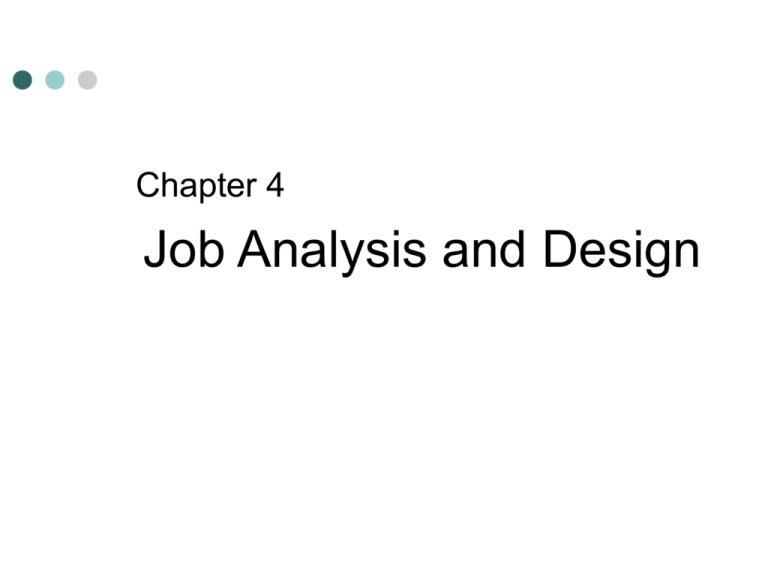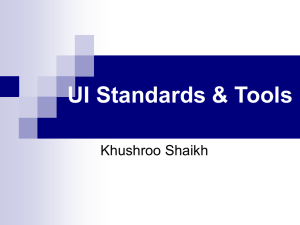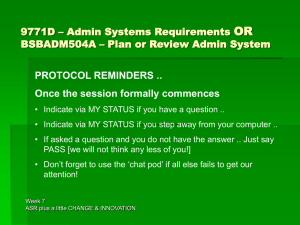After reading this chapter, you should be able to
advertisement

Chapter 4 Job Analysis and Design After reading this chapter, you should be able to: Understand the features and purpose of a job analysis process. List the techniques of data collection. Differentiate between job description and job specification. After reading this chapter, you should be able to (contd.): List the role of the environment in influencing job design. Enumerate the critical components of a job design. List the recent trends in a job design. What is job analysis ? Job analysis is a process of gathering relevant information about various aspects of a job, including its content, context and the job performer’s skill requirements. Features of job analysis Identification of tasks required to be performed. Defining the role, context, conditions, human behaviour, performance standards and responsibilities. Establishing the job’s worth to an organization. Establishes job-relatedness. Features of job analysis (contd.) Assists in the resource management and strategy formulation. Developing a job profile for each job and acts. Identifying the appropriate job for each employee. Better understanding of the impact of environmental changes on individual jobs. Features of job analysis (contd.) Identifying and removing unnecessary skills and other requirements for a job. Job improvements through job reengineering and job enlargement. Job improvements through job reengineering and job enlargement. Goals of job analysis Goals of job analysis (contd.) Job evaluation Job design and redesign Job classification Job description and job specification HR planning Goals of job analysis (contd.) Recruitment and selection Training and development Performance evaluation Wages and salary administration Safety and health Industrial relations Legal requirements Job analysis process Job analysis process (contd.) Determining the purpose of job analysis. Gathering background information about the job. Choosing representative jobs for analysis. Collecting relevant job information. Job analysis process (contd.) Reviewing the information gathered. Developing of job description and job specification. Techniques of data collection Techniques of data collection (contd.) Questionnaire method Job performance method Observation method Critical incident method (CIT) Interview method Diary maintenance method Technical conference method Types of questionnaires Types of questionnaires (contd.) Position Analysis Questionnaire (PAQ) model. Functional Job Analysis (FJA) model. Management Position Description Questionnaire (MPDQ) model. Work Profiling System (WPS) model. Types of questionnaires (contd.) Multipurpose Occupational Systems Analysis Inventory-closed Ended Questionnaire (MOSAIC) model. Common Metric Questionnaire (CMQ) model. Fleishman Job Analysis System (FJAS) model. Job description Job description is a document that specifies the tasks, duties, and responsibilities of the job and should certainly be relevant and accurate — Clyde E. Witt Components of a job description statement Job title Alternate title (if any) Job purpose (general purpose of the job) Code number (job identification number) Job holder title (title of the holder of this job.) Components of a job description statement (contd.) Job location Job type (full-time/part-time) Department/office (where this job is located.) Reporting authority (job title to which this job should report) No. of staff under this post (number and name of the job titles to be controlled by this job) Components of a job description statement (contd.) Job summary (a brief description about the job) Job duties (day-to-day tasks to be performed) Authority limits Working conditions required Components of a job description statement (contd.) Technical requirements Skills required for the job (minimum skills and competencies required for performing the job) Experience required for the job (minimum experience required for the performance of the job) Components of a job description statement (contd.) Special circumstances (information about night shifts, overtime, extensive travelling, etc.) Special requirements (special tools and equipment requirements for the job) Job specification Job specification is the process of inferring the human trait requirements presumed to be necessary for successful job performance. — R. Harvey and M. Wilson Broad titles in job specification Education and training Work experience Skills and competencies Physical strength and stamina Stress-coping ability Special needs Pro forma job specification statement Position title (title and designation of the job holder in the job). Department/office (where the job holder would be posted). Educational qualifications and training requirements. Experience (minimum number of years of experience the candidate must possess). Pro forma job specification statement (contd.) Work-based skills and competencies required. Behavioural skills and talents required (skills necessary for team work, effective leadership, diagnosing the problems, motivating oneself and others, effective communication, etc.). Pro forma job specification statement (contd.) Other attributes required (special qualities required for the performance of this job). Challenges affecting the effectiveness of job analysis Employee’s anxiety Management attitude towards job analysis Undue importance to job holders Environmental influence Absence of follow-up action Job design Job design is the process of determining the specific tasks to be performed, the methods used in performing these tasks, and how the job relates to other work in the organization. — R. Wayne Mondy Environmental influence on job design Ergonomics Characteristics of task structure Task assortment Level of autonomy and responsibility Practices Environmental influence on job design (contd.) Recognition and support Technological developments Strength of the union Corporate culture Working conditions Recent trends in job design E-commuting- E-commuting is a kind of work system in which the distance barrier is overcome by means of telecommunication. It allows the employees to perform their jobs without being present in office. Recent trends in job design (contd.) Flexi-time work- In this method, employees enjoy the freedom to choose their flexible starting and ending time of work within the scheduled working hours of the firm. The individual working hours are determined as per the convenience of each employee. Job enrichment Job enrichment refers to the development of work practices which challenge and motivate the employees to perform better. Strategies for job enrichment Self-managing teams Self-managing teams have the overall responsibility for the accomplishment of work or goal preparatory requirements for selfmanaging teams Work mapping Determining the size of the team Leadership development Fixing the team norms Job rotation Job rotation refers to moving employees from one job to another in a predetermined way. It enables an employee to perform diverse roles and gain exposure to the techniques and challenges of doing several jobs. Job reengineering Job reengineering is the process of streamlining jobs in the form of combining a few jobs into one, redistributing the tasks among various jobs and reallocation of resources. Job reengineering process Job reengineering process involves Pattern breaking Realigning with corporate goals Abolition of power structure Job reengineering process (contd.) Work flow redesigning Enhancing IT applications Redefining titles and positions Establishing a learning organization Performance-based incentives and rewards Job enlargement Job enlargement aims at making the job more attractive by increasing the operations performed by a person in the job. It transforms the jobs to include more and/or different tasks. Enlargement is of two types and these are Horizontal enlargement Vertical enlargement Participative management Participative management means allowing employees to play a greater part in the decision-making process. It helps in improving the quality of work life, job enrichment, quality circles, total quality management and empowerment. Peer performance review In this method, team members evaluate one another’s performance. Thus, performance appraisal for employees becomes more personalized and is conducted on a regular basis. High performance work design Characteristics of high performance work system are Presence of highly skilled, dynamic and loyal employees. Existence of flat, flexible and modern management. Capability to preserve the experienced and skilled employees for a long time. Existence of harmonious industrial relations. High performance work design (contd.) Presence of full-fledged self-managed teams. Existence of supportive rather than autocratic style of leadership and management. Payments system count on both team performance and individual skills.








